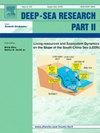由脂肪酸营养标志物推断的帝王海山链深海八爪珊瑚的饮食
IF 3
3区 地球科学
Q2 OCEANOGRAPHY
Deep-sea Research Part Ii-topical Studies in Oceanography
Pub Date : 2025-02-07
DOI:10.1016/j.dsr2.2025.105462
引用次数: 0
摘要
尽管八爪珊瑚(Cnidaria: Octocorallia)在创造和维持被称为珊瑚花园的深海群落方面发挥着重要作用,但人们对它们的饮食知之甚少。我们分析了位于皇帝海山链南部的Koko Guyot深海八珊瑚的脂肪酸组成,以确定它们的主要食物来源。数据表明,八爪珊瑚主要以浮游动物为食。然而,浮游动物对其饮食的贡献在不同物种之间差异很大,并由不同的浮游动物类群(食草动物、食肉动物或杂食动物)决定。珊瑚中一些单不饱和脂肪酸的含量有所增加,而多不饱和脂肪酸的比例也有所不同。在竹珊瑚Isidella中,鱿鱼类桡足类标记物富集最多(20:1n-9和22:1n-1)。除了桡足类标志物外,大多数珊瑚显示出高水平的肉食性标志物(18:1n-9),这表明其他(非鱿鱼类桡足类)物种对饮食有重要贡献。高水平的n-3多不饱和脂肪酸(PUFA),如硅藻标志物20:5n-3,表明Primnoidae科珊瑚吸收更多新鲜生产的物质。然而,在Paramuriceidae和kereides珊瑚中发现的高水平的n-6 PUFA(特别是20:4n-6)可能表明它们的饮食中涉及碎屑环节。FA分析有助于确定冷水八栖珊瑚的饮食,并为预测皇山链海底生态系统未来的潜在变化提供依据。本文章由计算机程序翻译,如有差异,请以英文原文为准。
Diet of deep-sea octocorals from the Emperor Seamount Chain inferred by fatty acid trophic markers
Despite the important role that octocorals (Cnidaria: Octocorallia) play in creating and maintaining deep-sea communities known as coral gardens, little is known about their diet. We analyzed the fatty acid compositions of deep-sea octocorals collected from Koko Guyot, located in the southern Emperor Seamount Chain, to identify their main food sources. The data suggests that octocorals feed mainly on zooplankton. However, the contribution of zooplankton to their diet varies greatly among different species and is determined by different zooplankton groups (herbivores, carnivores, or omnivores). This is evidenced by the increased content of some monounsaturated fatty acids (FA) and the different ratios of polyunsaturated fatty acids in corals. In bamboo coral Isidella, we observed the maximum enrichment in calanoid copepod markers (20:1n-9 and 22:1n-1). In addition to the copepod markers, most corals showed a high level of the carnivore marker (18:1n-9), which indicates a significant contribution of other (non-calanoid copepods) items to the diet. The high level of n-3 polyunsaturated fatty acids (PUFA) such as the diatom marker 20:5n-3 suggests that corals of the family Primnoidae take up more freshly produced material. However, the high level of n-6 PUFA (especially, 20:4n-6), found in Paramuriceidae and Keroeides corals may indicate the involvement of detrital links in their diet. FA analysis is useful for identifying the diet of cold-water octocorals and provides a basis for prediction of future potential changes of the bottom ecosystems in the Emperor Seamount Chain.
求助全文
通过发布文献求助,成功后即可免费获取论文全文。
去求助
来源期刊
CiteScore
6.40
自引率
16.70%
发文量
115
审稿时长
3 months
期刊介绍:
Deep-Sea Research Part II: Topical Studies in Oceanography publishes topical issues from the many international and interdisciplinary projects which are undertaken in oceanography. Besides these special issues from projects, the journal publishes collections of papers presented at conferences. The special issues regularly have electronic annexes of non-text material (numerical data, images, images, video, etc.) which are published with the special issues in ScienceDirect. Deep-Sea Research Part II was split off as a separate journal devoted to topical issues in 1993. Its companion journal Deep-Sea Research Part I: Oceanographic Research Papers, publishes the regular research papers in this area.

 求助内容:
求助内容: 应助结果提醒方式:
应助结果提醒方式:


